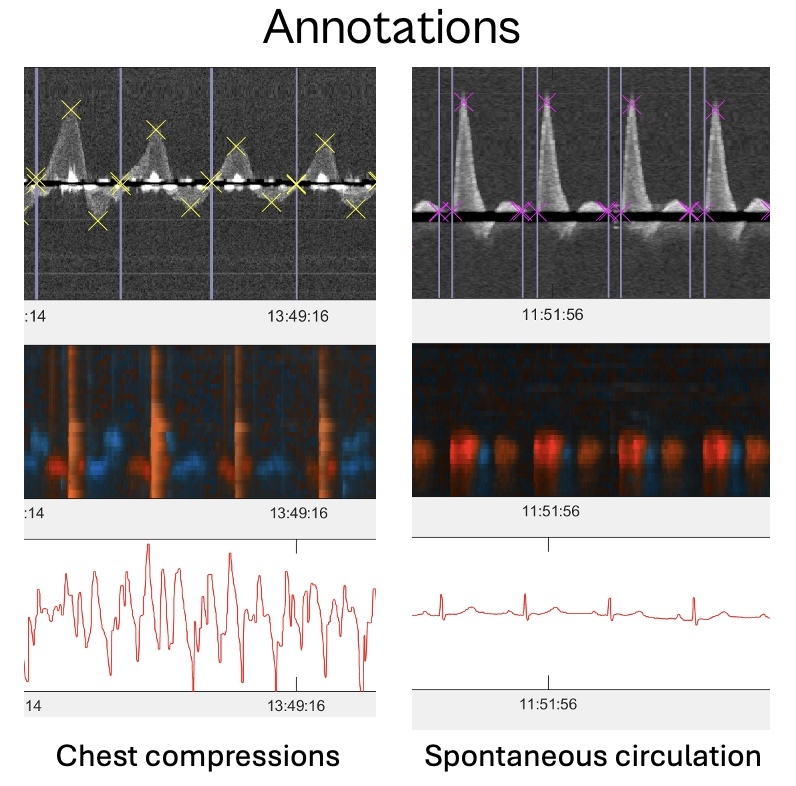Final ID: Sa1406
Detection of Spontaneous Circulation during Cardiopulmonary Resuscitation using Continuous Carotid Artery Doppler Blood Flow monitored by AI in an Animal model of Cardiac Arrest.
Abstract Body: Introduction:
Manual pulse palpation during cardiopulmonary resuscitation (CPR) to check for spontaneous circulation is unreliable and time-consuming. Therefore, we have developed a RescueDoppler device with a small ultrasound probe that attaches to the neck and continuously monitors potential blood flow in the carotid artery. To assist rescuers, automatic real-time feedback on the presence of spontaneous circulation is needed.
Hypothesis:
Artificial Intelligence (AI) can assist during CPR and identify spontaneous circulation.
Aims:
To provide automatic feedback on spontaneous circulation and chest compressions during cardiac arrest using advanced deep-learning techniques.
Methods:
We conducted a retrospective study using RescueDoppler carotid flow velocity pattern from 5 pigs, where ventricular fibrillation was induced with an implantable cardioverter-defibrillator. Manual chest compressions were performed according to guidelines. We annotate pulsed wave spectral velocity curves (n=2610) and label them as compressions or spontaneous circulation (Figure 1). One second pulses are extracted from the recordings using annotations and saved as images. We perform a one-vs-rest cross-validation test by keeping one subject out for testing in each fold. All the images are normalised to have values ranging between 0 and 1. Then VGG16 (state-of-the-art architecture), is employed to extract relevant features. An artificial neural network is trained to classify between compression and spontaneous signals. Grad-CAM, an explainable AI (XAI) method, is used to identify potential regions of interest for the model to make certain predictions. Figure 2 and 3 show the original images along with XAI heatmaps overlayed.
Results:
Our model achieve a mean sensitivity of 94%, specificity of 95%, positive predictive value (PPV) of 95%, and negative predictive value (NPV) of 93%. High sensitivity and specificity across all folds suggest that the model is unbiased, and high PPV and NPV indicate a strong likelihood of accurate predictions. According to XAI heatmaps, the model focuses on key areas such as the dicrotic notch and diastolic flow for detecting spontaneous circulation, as well as baseline noise and peaks for identifying compressions when making its predictions.
Conclusion:
In a porcine model of cardiac arrest, we demonstrated that deep learning techniques can harness the potential of AI to identify spontaneous circulation and compressions during CPR, achieving highly accurate results.
Manual pulse palpation during cardiopulmonary resuscitation (CPR) to check for spontaneous circulation is unreliable and time-consuming. Therefore, we have developed a RescueDoppler device with a small ultrasound probe that attaches to the neck and continuously monitors potential blood flow in the carotid artery. To assist rescuers, automatic real-time feedback on the presence of spontaneous circulation is needed.
Hypothesis:
Artificial Intelligence (AI) can assist during CPR and identify spontaneous circulation.
Aims:
To provide automatic feedback on spontaneous circulation and chest compressions during cardiac arrest using advanced deep-learning techniques.
Methods:
We conducted a retrospective study using RescueDoppler carotid flow velocity pattern from 5 pigs, where ventricular fibrillation was induced with an implantable cardioverter-defibrillator. Manual chest compressions were performed according to guidelines. We annotate pulsed wave spectral velocity curves (n=2610) and label them as compressions or spontaneous circulation (Figure 1). One second pulses are extracted from the recordings using annotations and saved as images. We perform a one-vs-rest cross-validation test by keeping one subject out for testing in each fold. All the images are normalised to have values ranging between 0 and 1. Then VGG16 (state-of-the-art architecture), is employed to extract relevant features. An artificial neural network is trained to classify between compression and spontaneous signals. Grad-CAM, an explainable AI (XAI) method, is used to identify potential regions of interest for the model to make certain predictions. Figure 2 and 3 show the original images along with XAI heatmaps overlayed.
Results:
Our model achieve a mean sensitivity of 94%, specificity of 95%, positive predictive value (PPV) of 95%, and negative predictive value (NPV) of 93%. High sensitivity and specificity across all folds suggest that the model is unbiased, and high PPV and NPV indicate a strong likelihood of accurate predictions. According to XAI heatmaps, the model focuses on key areas such as the dicrotic notch and diastolic flow for detecting spontaneous circulation, as well as baseline noise and peaks for identifying compressions when making its predictions.
Conclusion:
In a porcine model of cardiac arrest, we demonstrated that deep learning techniques can harness the potential of AI to identify spontaneous circulation and compressions during CPR, achieving highly accurate results.
More abstracts on this topic:
Analysis of Ventricular Fibrillation Waveform Response to Asphyxial Hemodynamics in an Infant Swine Model of Out-of-Hospital Cardiac Arrest
Jackson Aaron, Gumucio Jorge, Menegazzi James, Salcido David
A Comparison of Synchronized Versus Unsynchronized Mechanical Chest Compressions in a Swine ModelMarill Keith, Menegazzi James, Gumucio Jorge, Salcido David



